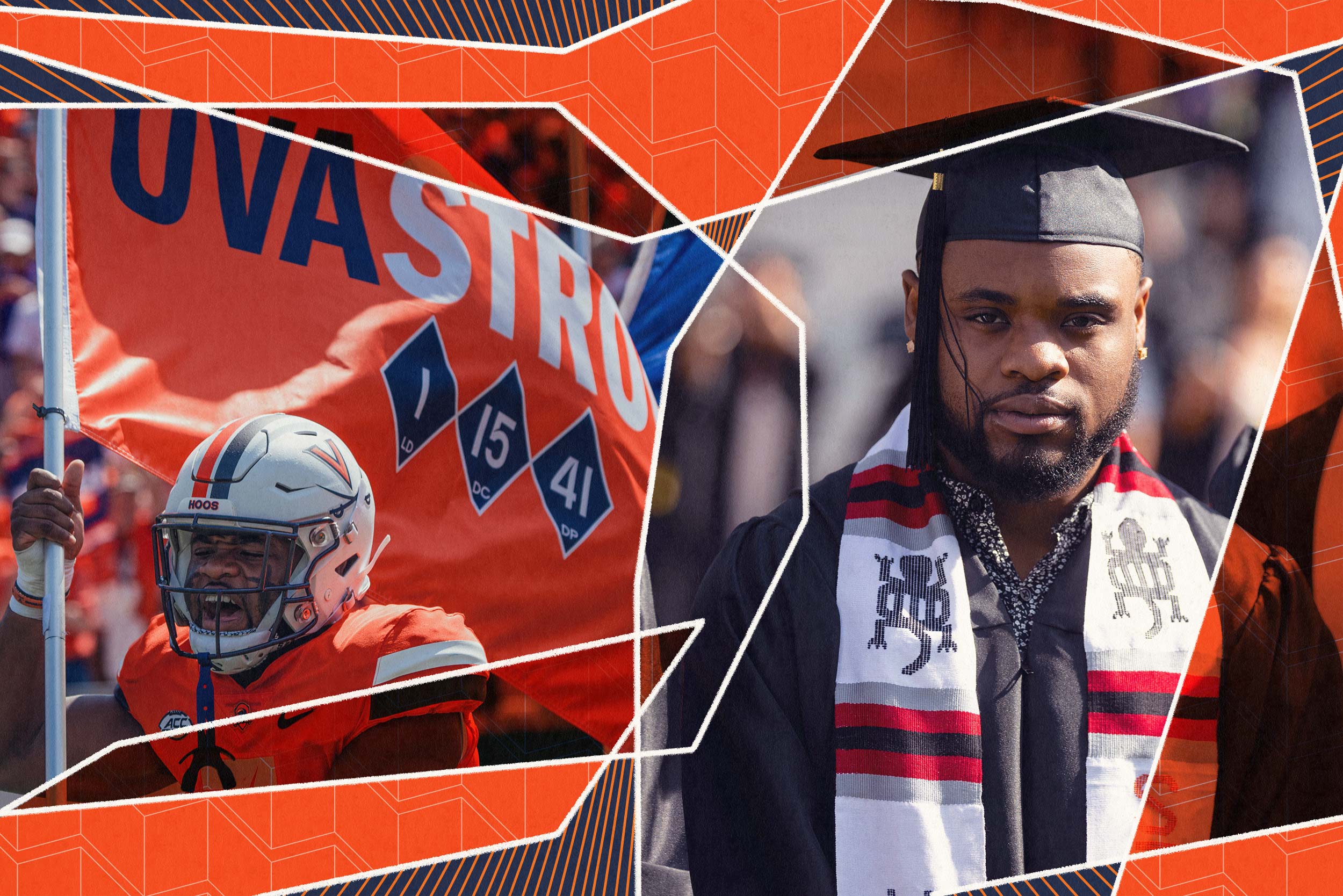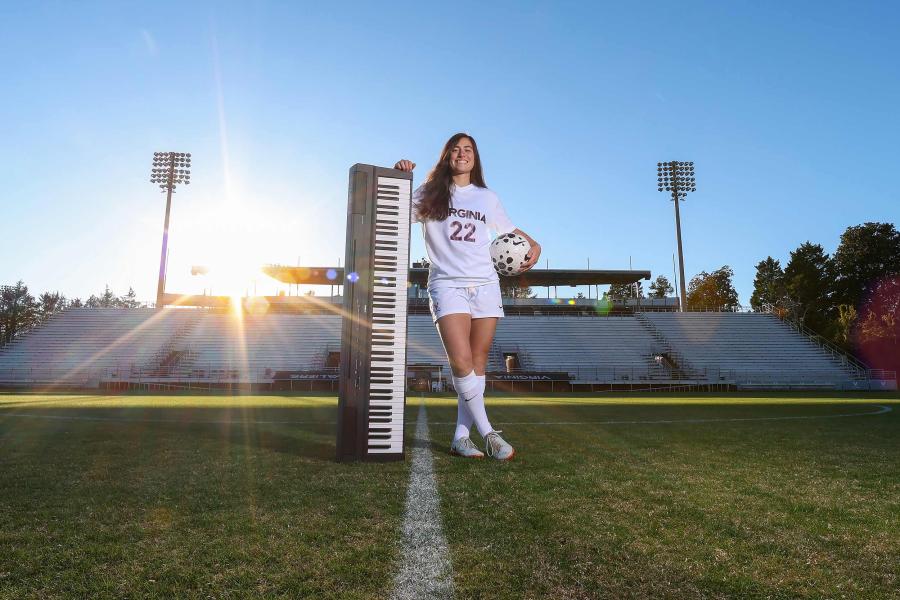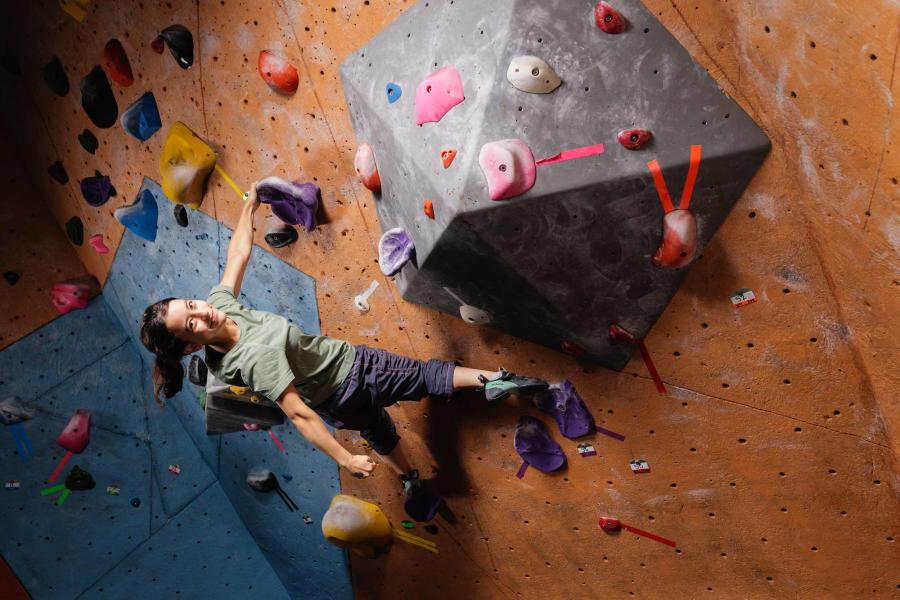Mike Hollins, who already holds a bachelor’s degree from the University, was the fitting flag-bearer for the Cavaliers’ “UVA Strong” game against James Madison University earlier this season. (Illustration by Alex Angelich, University Communications, left photo by Emily Faith Morgan, University Communications, right photo contributed)
On an afternoon in late spring of 2022, months before the horrific events of Nov. 13 on the University of Virginia’s Grounds, Adam Brooks was hosting his 8-year-old son, Landon, in his McCue Center office when a visitor popped in.
Brooks, UVA’s assistant athletic director for academics and student development, often has Wahoo student-athletes coming through his door. This one brought a smile across his face.
“Landon,” Brooks said, “this is Mike.”
Landon Brooks is the quintessential young sports enthusiast, constantly in awe of his helmet-bearing heroes scoring touchdowns on the football field or hitting home runs on the baseball diamond. In this moment, he looked up to see a running back for the UVA football team not only introducing himself, but inviting conversation.
“What’s up, Landon?” Mike Hollins asked. “You play any sports?”
Soon, the second grader and the fourth-year college student were hitting if off.
“And,” Brooks said, “Landon left that day with Mike Hollins as one of his new favorite players.”
Nowadays, Landon has plenty of company. While Wahoo fans may not have had a personal interaction with Hollins, they were on their feet cheering him last month when he scored two touchdowns against James Madison University in the first home game of the season.
The emotional scenes – capped by sideline hugs from his brother, Deuce – were part of the Hollins story that goes back to last November, when he survived a shooting that killed teammates Devin Chandler, Lavel Davis Jr. and D’Sean Perry on a bus outside Culbreth Garage.
Hollins, shot after returning to the bus to try to save his teammates, spent a week in the hospital in critical condition. In the months that followed, Hollins’ recovery and his return to football have been a symbol of hope for a UVA community in its quest to press forward. This fall, he’s played in five of the Cavaliers’ six games, and his three touchdowns are second-most on the team.
But with all the attention from national media outlets like ESPN and The Washington Post focused on Hollins’ athletic comeback, few have asked about his academic comeback, which, Hollins will tell you, is the more important of the two.
While still early in his recovery, he finished his bachelor’s degree with a double major in American studies and African American and African studies through the College of Arts & Sciences, regularly carding a 3.0 GPA.
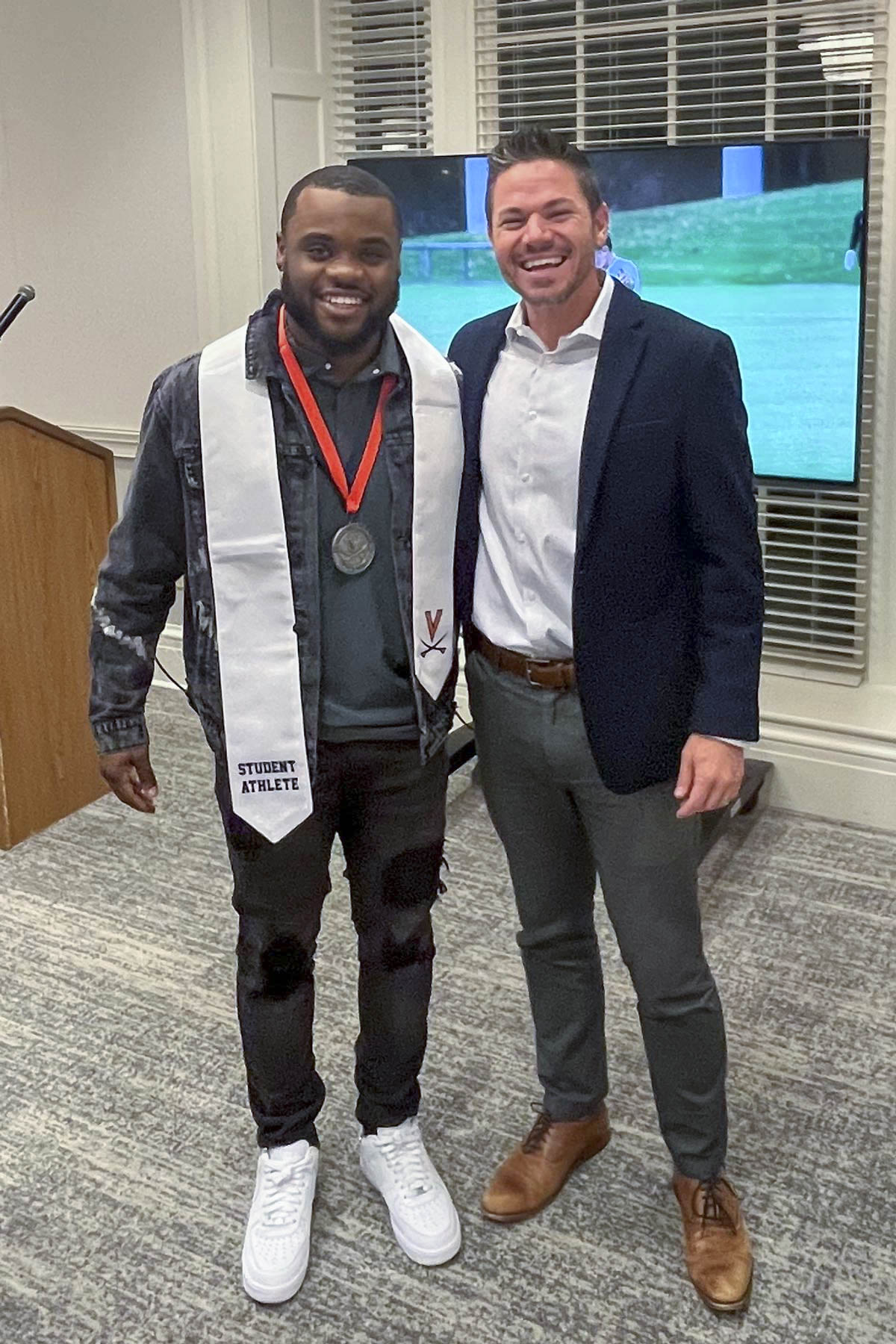
When Adam Brooks saw Hollins at a graduation ceremony last December, shortly after the shooting, he made sure to get a picture with Hollins to send back to his son, who had befriended Hollins months earlier. (Contributed photo)
But in accordance with using his fifth year of playing eligibility, he decided to pursue a master’s degree. Under the best of circumstances, balancing football and post-graduate study would be challenging. But for Hollins, these were not the best of circumstances.
‘Mike Treats People the Right Way’
Hollins came to UVA as a touted football prospect who accepted a scholarship offer to play for the Wahoos over the 15 other NCAA Division I programs that sought him, including the University of Alabama.
The Baton Rouge, Louisiana, native said he selected the school more than 1,000 miles away because he felt UVA provided the best educational opportunity.
“I could have picked anywhere to go play football,” Hollins said, “but I didn’t want to be remembered as just a football player, because I knew [football] was just a short time in your life.”
Hollins had a perspective at a young age that Brooks, who’s helped Cavalier athletes with their academic affairs since 2009, could sense from the moment Hollins stepped on Grounds.
“I think from the jump,” Brooks said, “it was pretty clear to me that he really wanted to not only do his family proud, but really find a major, find a course of study, find something that he was really committed to and interested in and be true to his identity.”
What Brooks heard through Hollins’ professors is that Hollins is a charismatic student who only enhanced his environment.
“Mike treats people the right way,” Brooks said. “So, any constructive feedback from an instructor would be that maybe he was falling behind in his work. But there was never anything about his character.

Last April’s Blue-White Game at Scott Stadium marked the first time the team had played in front of fans since the shooting. It was a particularly emotionally afternoon for Hollins, who was joined on the field by his brother, Deuce. (Photo by Emily Faith Morgan, University Communications)
“I always knew that if Mike actually got to talk to the instructor and meet with them, only positives were going to come out of it after that point.”
From what she had gathered from her colleagues, Christian Steinmetz was delighted to welcome Hollins to a couple of her graduate-level courses last spring.
Steinmetz, an assistant professor in the School of Education and Human Development, admired his resilience as she hosted him for “Counseling Student-Athletes” and “Diversity, Inclusion and Equity in Higher Education.”
“But,” she said, “I was also thinking about his mental and emotional health. In the counseling class, we do talk a lot about transitions and mental wellness in that class, and I was thinking that it could either help him in some ways or it could be difficult for him.”
‘Getting a Piece of My Normalcy Back’
Hollins said he was excited to get back in the classroom following the shooting because it meant he was inching closer to the routine he once had. “I was getting a piece of my normalcy back,” he said.
Except it wasn’t that simple. Normally gregarious, Hollins initially struggled with again being around fellow students on Grounds as he felt their stares and heard their questions.
This was Hollins’ new life, forever being associated with a tragedy.
“Everyday we wake up, our hearts beat for you🧡💙.” - @MikeHollins7
— Virginia Football (@UVAFootball) April 17, 2023
1.15.41🕊#UVAStrong | #GoHoos⚔️ pic.twitter.com/41VWYAA8EO
“Navigating that,” Hollins said, “it took some time and, you know, I had to talk to some people here around the [football] facility on how should I respond if I wasn’t feeling up to it one day. Or if I wasn’t in the mood one day. ... How do I be respectful?”
UVA running backs coach Keith Gaither is among the group Hollins leans on during these confusing times. His advice: It’s fine to be vulnerable.
“It’s not easy sitting in class,” Gaither said. “You’ve been identified by the incident. And I just told him, ‘Hey, look, you don’t have to be strong. It’s OK to cry. It’s OK to talk about it.’”
Hollins’ spring course load was, by intention, mostly online, with the exception of his classes with Steinmetz. She admits she noticed days when Hollins’ focus seemed elsewhere, but the good days far outweighed the bad.
In the diversity course, one that Steinmetz said routinely tackles “difficult” topics, Hollins was “one of the people who kept conversations going.”
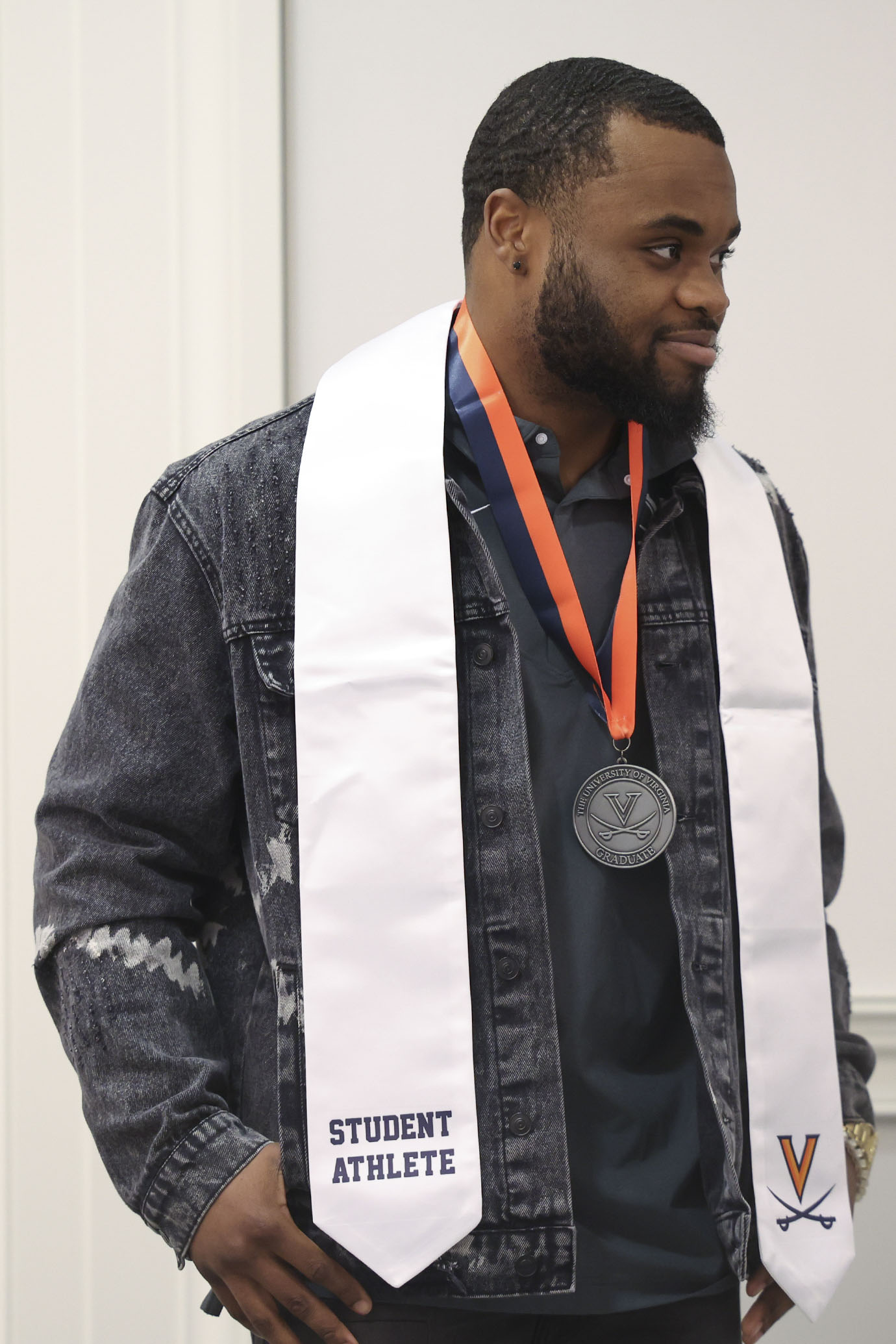
Hollins, last December, completed his double major of American studies and African American and African studies. He’s now pursuing a master’s degree in higher education. (UVA Athletics photo)
He successfully completed challenging assignments in both courses, including a captivating photo essay in the diversity course that dived into the University’s history with the Charlottesville community and highlighted Vinegar Hill, a once-thriving Black community that was razed in the 1960s.
And while the shooting was never directly addressed, Hollins was honest about how his perspective was altered by going through such a chilling experience.
“He shared how he viewed athletics differently,” Steinmetz said, “though a different lens.”
It was the learned mindset of a young man who nearly lost everything, including the ability to play the sport he loves.
“Seeing how life can be changed in such a split second and how things can be taken,” he said, “it made me a lot more grateful for my decision, and for coming here and getting a UVA degree.”
Continuing To Inspire
At a small graduation ceremony last December for student-athletes who finished their degrees early – such as Hollins, who completed his double major in only seven semesters – Brooks, like many in the room, saw Hollins for the first time since the shooting.
Hollins was walking around, hugging people, and telling them that he loved them.
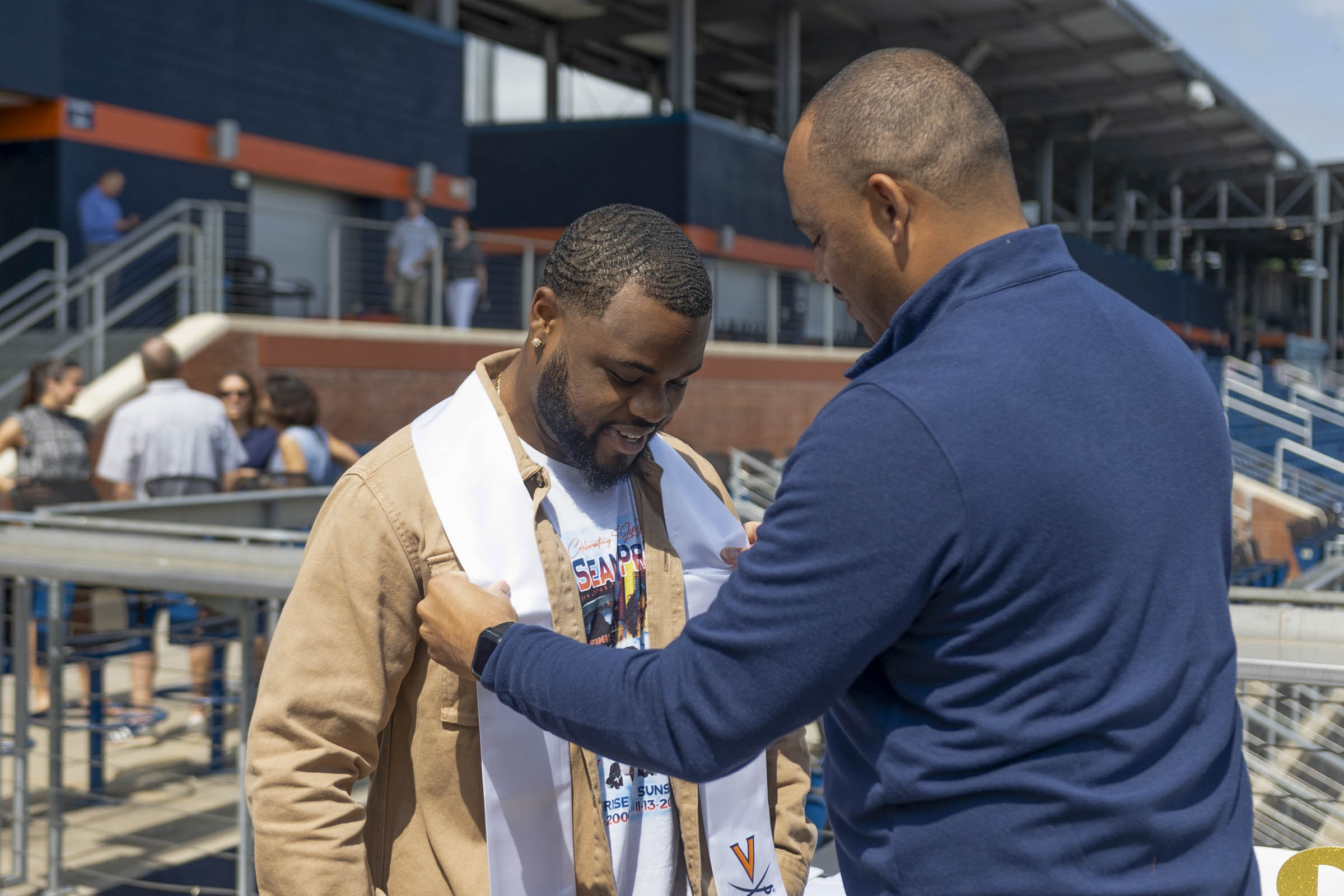
UVA head football coach Tony Elliott places a graduation stole on Hollins during a ceremony at Disharoon Park. (UVA Athletics photo)
Brooks soon sent two texts back home. One was to his wife to tell her how inspired he was by Hollins’ mere smiling presence. And the other text was a photo to his son, Landon.
“Look, buddy,” Brooks wrote, “here’s Mike better than ever.”
“Wait, that’s Mike?” Landon responded. “He’s doing great!”
The UVA community could relate to Landon’s gleeful relief in that moment. Hollins, because of unimaginable circumstances, became someone to rally behind. Any sign of progress was to be celebrated.
Nearly a year later, Hollins has returned to the football field and excelled in the classroom. He is on track, remarkably, to earn his master’s in higher education this academic year.
The next step in this continued rise is the establishment of a career.
Gaither sees Hollins becoming a pastor or a youth minister. Steinmetz imagines Hollins working in a college athletics department and helping student-athletes develop as people. And, to Brooks, Hollins will be somewhere, uplifting someone.
“Mike is just a world-class individual,” Brooks said, “and I would have said that prior to last November. I struggle to see Mike not working with a population where he can make a day-to-day difference. I almost cringe at him being in an office space without having human interaction.
“The world needs Mike Hollins to be interacting with it in some capacity.”
For the thousands who have watched Hollins’ odyssey from a distance, it’s impossible not to cheer for No. 7 when he lines up in the backfield. And for the few who have shared the journey with Hollins, they’ll say they’ve gotten more out of it than he has.
“‘Inspirational’ is probably the easiest thing to say about Mike Hollins right now, but it’s true,” Brooks said. “You just feel better after you’re around him.”
And to Landon, who was befriended by Hollins only a year ago, Hollins will always be a hero.
Media Contacts
University News Senior Associate University Communications
fpa5up@virginia.edu (434) 924-6856
